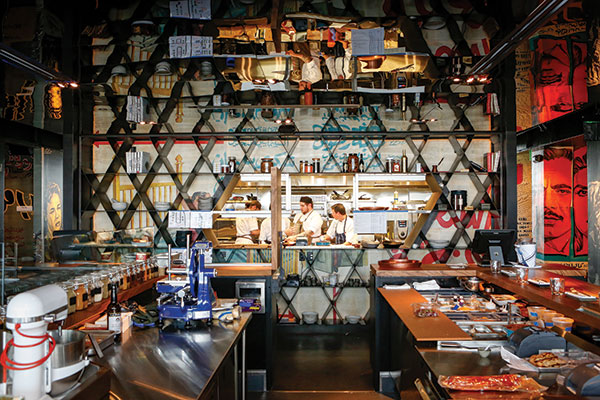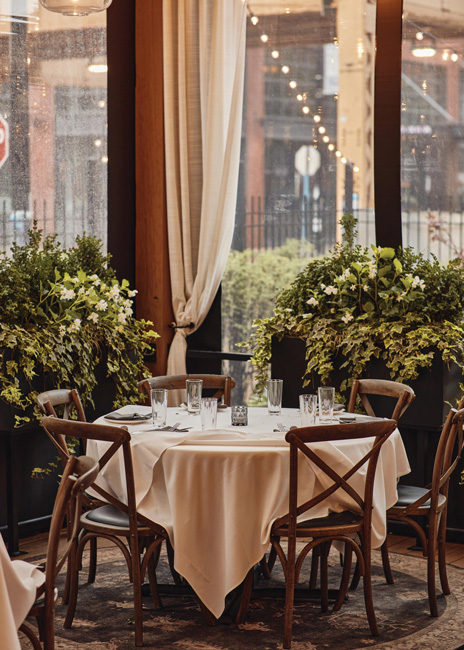 Image courtesy of Aria GroupSpring is in the air, and for restaurant operators that means an opportunity to boost revenue through additional seating outside.
Image courtesy of Aria GroupSpring is in the air, and for restaurant operators that means an opportunity to boost revenue through additional seating outside.
Rooftops, courtyards, backyards, streets, parking lots and alleyways are all prime real estate for expanding a restaurant’s capacity and offering a unique experience, distinct from the indoors.
An outdoor space needs to look thoughtful and intentional, says Joshua Zinder, AIA, NCARB, LEED AP, managing partner of JZA+D, Princeton N.J. It also needs to be easily accessed by service staff and has to offer the same level of service guests would experience inside.
“Service access is important,” says Frank Cavanaugh, principal, Aria Group, Oak Park, Ill. “The path from the kitchen to these outdoor spaces should be as efficient as possible. Serving these spaces through the restaurant entry doors should be avoided.”
Another Broken Egg Cafe, based in Orlando, Fla., has 97 locations in 16 states, and adds outdoor areas whenever it can, boosting seating capacity by 10% to 30%. “The ability to use those patios, particularly on higher volume days and weekends, helps because every seat has a sales element to it,” says Jeff Sturgis, chief development officer.
The chain covers outdoor areas when possible and likes to install both a shade system — to block sun and cold — as well as a mini split AC unit to provide heat and cooling to maximize the days the space can be used.
Outdoor dining areas can either stand-alone or can bleed into the interior of a restaurant, blurring the lines between both. Garage doors or sliding nano doors help achieve this, says Zinder.
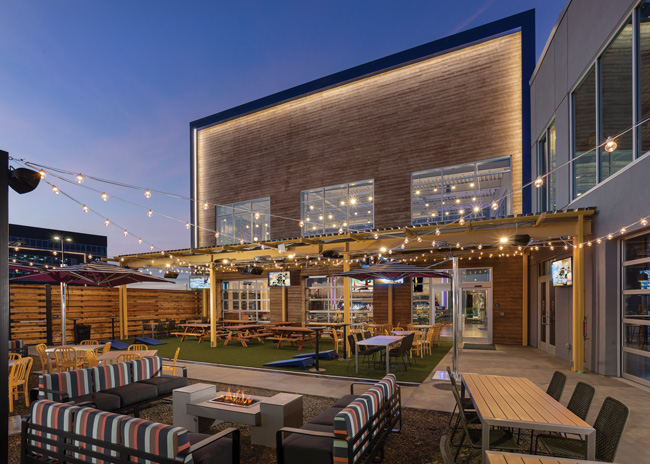 "Service access is important," says Frank Cavanaugh, principal, Aria Group. "The path from the kitchen to these outdoor spaces should be as efficient as possible. Serving these spaces through the restaurant entry doors should be avoided." Image courtesy of Aria Group
"Service access is important," says Frank Cavanaugh, principal, Aria Group. "The path from the kitchen to these outdoor spaces should be as efficient as possible. Serving these spaces through the restaurant entry doors should be avoided." Image courtesy of Aria Group
Greening it Up
Including plants outside can soften a space and communicate a feeling of freshness.
Adding softness and organics is appealing to guests, says Cavanaugh. “We often include perimeter, in-ground planting strips between slabs or sidewalks or a vertical trellis to buffer a dining area from street traffic, parking lots or passing headlights in the evening.”
Plants, Cavanaugh adds, provide softness, freshness, aroma and color. Sometimes he likes to use landscaping to block car headlights going by, especially if they’ll be pointing directly at the seating area. This can also be a low wall or fence, he adds.
Zinder likes to create some separation between outdoor areas and public areas, so diners aren’t under the feet of passersby. Bushes or planters can create a buffer without being too harsh, he says. These buffers can make the restaurant feel more intimate, Zinder notes, and give a feeling of safety, since they’re enclosed. However, they’re not really needed in QSR and fast-casual restaurants, he points out, since those are much faster experiences. Planters and lattices with ivy growing up them can also create some separation, says Zinder, who’s not opposed to artificial plants.
When it comes to the type of greenery, Cavanaugh opts for native plants so they require as little attention as possible and are more likely to ward off pests and diseases and can attract butterflies. For barriers he’s a fan of evergreens or boxwood, but also likes annuals in raised planters.
Planters can also have a practical use by creating the perimeter of an outdoor space and can help create flow, guiding guests through it. And they can be a handy way to hide any ugly items.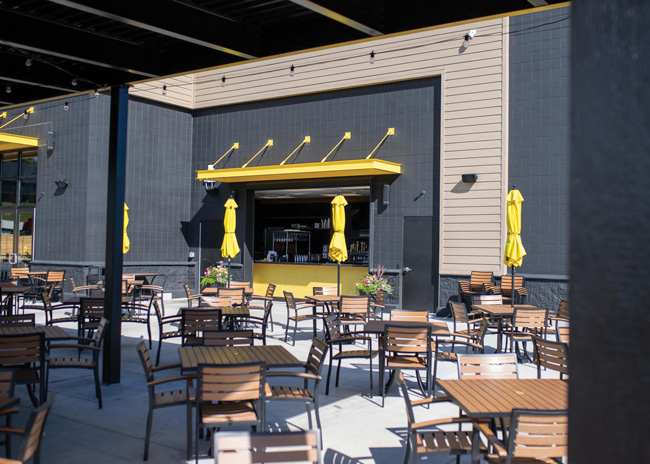 Outdoor bars needs to be completely weatherproofed, says Marcus Calverley, project manager, Boelter, a commercial foodservice solutions and kitchen design company in Milwaukee. Image courtesy of Boelter
Outdoor bars needs to be completely weatherproofed, says Marcus Calverley, project manager, Boelter, a commercial foodservice solutions and kitchen design company in Milwaukee. Image courtesy of Boelter
Lighting the mood
Exterior lighting can range from table lamps to the more ubiquitous daisy chained lights, and it’s important that lighting has two functions: to create ambiance and to allow guests to see each other and the menu.
If there’s a roof, Cavanaugh likes to include lights, such as recessed or string lights. He’ll even add skylights for daytime concepts to help brighten up the space. Sometimes clients request pendant lighting, he says, “but you have to get them on fairly rigid stems, so they don’t swing all over the place if there’s a breeze.”
Table lighting is also a nice addition and he’s a fan of rechargeable LEDs.
Weather considerations
Another Broken Egg uses its patios for three seasons, sometimes four, depending on the location, but to do that, the space must have protection from the sun in the summer and some form of heat in the winter.
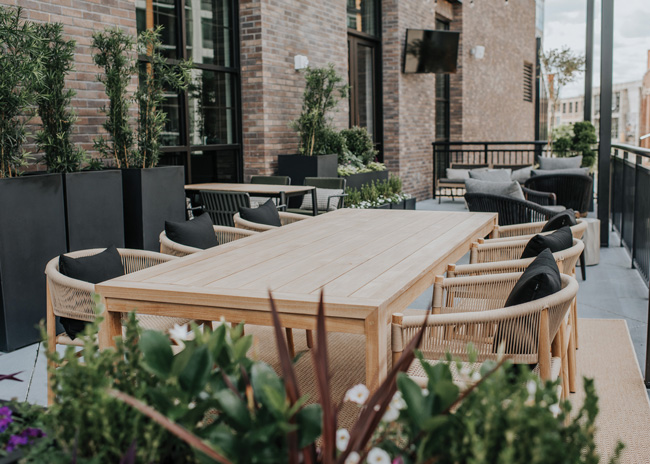 Ice and drainage can be difficult in outdoor bars, says Shay Lam, studio leader, Nelson Worldwide. Image courtesy of NelsonA simple way to cool a space is to think about how it’s oriented to catch breezes, says Keith Short, FCSI, CFSP, Fe3, design principal, Fishman & Associates, Venice, Fla. In the winter, these spaces can be surrounded by modular enclosures or mobile thick brush plants to block the colder winds.
Ice and drainage can be difficult in outdoor bars, says Shay Lam, studio leader, Nelson Worldwide. Image courtesy of NelsonA simple way to cool a space is to think about how it’s oriented to catch breezes, says Keith Short, FCSI, CFSP, Fe3, design principal, Fishman & Associates, Venice, Fla. In the winter, these spaces can be surrounded by modular enclosures or mobile thick brush plants to block the colder winds.
Having some sun on guests in the winter can be nice but is less pleasant in the summer heat, so Short uses modeling software to conduct a solar path study. “Then we can implement fixed and/or removable structural elements like shade cloths, retractable awnings with or without heat lamps, awnings that can provide water mist during hot days,” he says.
For the warm weather, fans along with roof vents are a must under hard roofs, says Cavanaugh. For the winter, he likes to include full or partial hard roofs, provided with roller shaded vinyl and heaters.
If enclosed with roller vinyl in cold weather, it’s critical to design for fresh air intake and exhaust or even just simple ceiling vents, Cavanaugh points out, otherwise condensation can build up without adequate air flow. He’s starting to use motorized louvered trellis systems to close off patios from light rain, which then open in clear weather.
Roller shade systems with clear vinyl that can roll down and shield guests from cold temperatures are being used more, Cavanaugh says, and can be opened up in the warmer weather. He cautions that typically a sprinkler system is required for fire protection and a gated means of egress.
To heat spaces Cavanaugh likes outdoor radiant heaters. Gas-supplied heaters are also an option, he adds, “but more expensive to install and cumbersome to look at with all the gas pipes.
When it comes to heating, Short’s a fan of visual flames, which he says helps diners feel psychologically warm. He points to fire pits that have a table around them, which tend to keep guests warmer than a heat lamp and radiate heat on the underside, too.
 An outdoor space needs to look thoughtful and intentional, says Joshua Zinder, managing partner of JZA+D, Princeton N.J. Photo by Michael Slack, courtesy of JZA+D
An outdoor space needs to look thoughtful and intentional, says Joshua Zinder, managing partner of JZA+D, Princeton N.J. Photo by Michael Slack, courtesy of JZA+D
A Bar Focus
The addition of a bar to an outdoor area can bring a lot of energy to a space, though the outdoors comes with several issues to contend with.
First, a bar needs to be completely weatherproofed, says Marcus Calverley, project manager, Boelter, a commercial foodservice solutions and kitchen design company in Milwaukee. “Manufacturer warranties often have fine print related to outdoor use and exposure to the elements,” and he works to ensure his clients don’t void warranties.
In warm climates, it’s important to be aware of bugs, Calverley says. If the bar serves a lot of sugary drinks, it’s important to protect the area from being overrun with flies and pests. Undercounter, covered, refrigerated condiment stations around 24 inches wide can keep everything out of the elements. These, says Calverley, are very easy to clean and don’t require a drain. “Any outdoor bar I’m designing will have one of these.”
Calverley’s also a fan of air screens, which can keep bugs out. These, he says, are not loud and the amount of air they generate prevents flying insects from entering the bar space. Ideally the air screen surrounds the entire bar, but if that’s too much expense, focus on the service station, he suggests, because drinks sit here waiting to be picked up by servers. Ideally place the machine itself close to that area, too.
If a bar backs up to an inside bar it can also be nice to put frozen drink machines in between them, he says, so customers can see them inside.
For materials, Calverley suggests stainless steel “because the moment equipment gets wet that moisture can create mold and deterioration.” And all stainless steel can come with almost any finish, be it powdered, laminate or a stone look. “So, it’s not limiting from an interior design standpoint.” For bar tops he recommends against anything porous like wood and prefers to go with stone or a solid surface material.
If a bar is going to be closed for the winter, plan “so you can easily batten down the hatches, blow out the drains, plug the drain lines, disconnect the soda lines, and disconnect anything concerning plumbing and electricity,” Calverley says. “We need to consider how to close a bar down. It needs to be covered on all sides. Consider how we keep it so it still looks nice.”
Ice and drainage can be difficult in outdoor bars, says Shay Lam, studio leader, Nelson Worldwide, Minneapolis, Minn. It can be difficult to transport and hold ice, especially in a rooftop area if there’s no ice machine on that level. Also consider dishwashing, he says. Will glasses be washed at the outside bar or will they need to be taken inside to a distant dishwasher? Lam suggests that if a project does include an ice machine or dishwasher in an outdoor space, make sure guests can never hear them.
After hours must also be considered. Liquor bottles and equipment may need to be locked up, says Calverley. Also consider whether extra lighting is needed for clean-up and whether any TVs or entertainment equipment can be stolen and beaten up by weather.
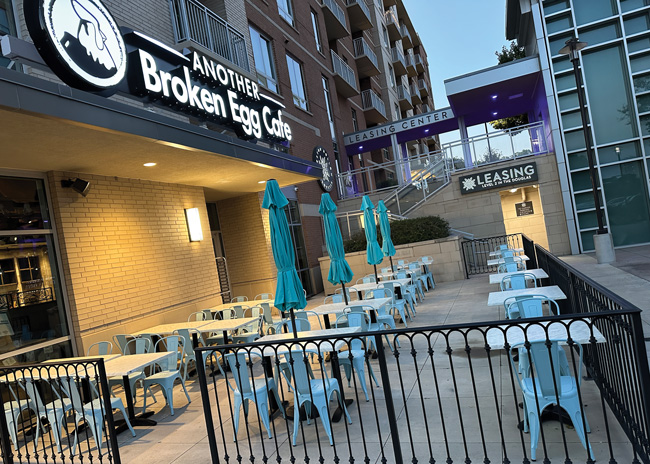 Another Broken Egg Cafe, based in Orlando, Fla., has 97 locations in 16 states, and adds outdoor areas whenever it can, boosting seating capacity by 10% to 30%. Image courtesy of Another Broken Egg
Another Broken Egg Cafe, based in Orlando, Fla., has 97 locations in 16 states, and adds outdoor areas whenever it can, boosting seating capacity by 10% to 30%. Image courtesy of Another Broken Egg
Extra Touches for Outdoor Spaces
Add outdoor rugs to soften spaces, says Frank Cavanaugh, principal, Aria Group, “especially if you didn’t put a lot of money into your floor surface.” Another option is colored or stained concrete to warm up an outdoor area.
Add some seasonal flowers for a touch of color, says Cavanaugh.
Keith Short, FCSI, CFSP, Fe3, design principal, Fishman & Associates, likes to powder coat any stainless-steel equipment that’s outside. This is particularly effective with bar equipment and refrigeration. It also provides some protection for the equipment, he adds.
Water features can enhance the scene. The outdoor space should have some natural element that evokes tranquility while dining, says Short. Also, the combination of the sound of water cascading blending in with music in the background is appealing. He’s particularly a fan of a water feature integrated within an herb garden “which demonstrates sustainability and perfumes the air around the outdoor dining space.”
A huge fireplace can add warmth, both in a physical and psychological sense, says Shay Lam, studio leader, Nelson Worldwide.
Make alleyway dining feel part of the restaurant by adding something unique, like graffiti, says Joshua Zinder, managing partner of JZA+D.


